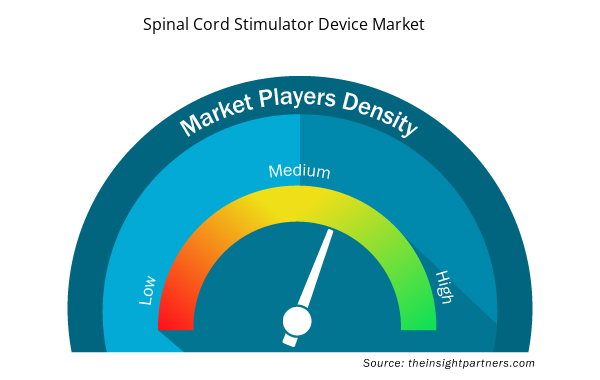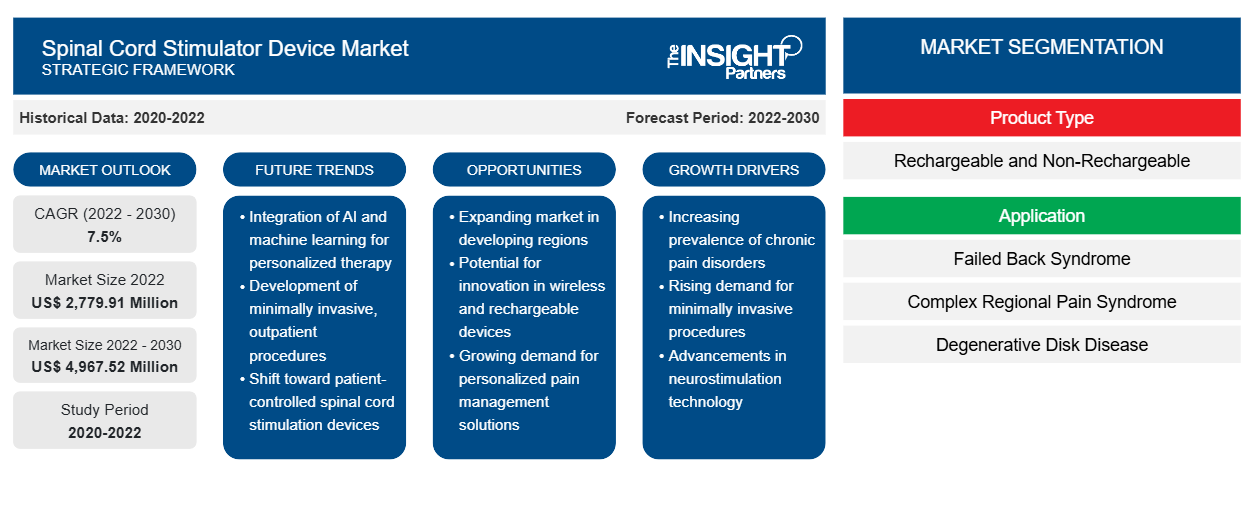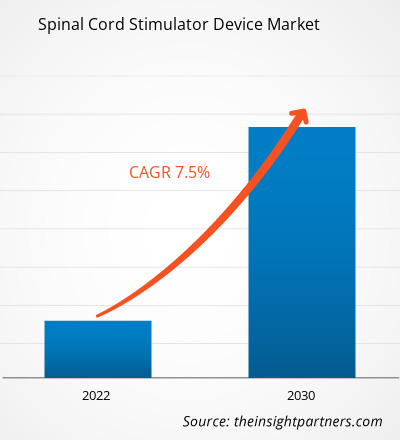[調査レポート] 脊髄刺激装置市場は、2022年の27億7,991万米ドルから2030年には49億6,752万米ドルに成長すると予想されており、2022年から2030年にかけて7.5%のCAGRを記録すると予想されています。
市場洞察とアナリストの見解:
脊髄刺激装置は、低レベルの電気信号を脊髄に直接送信することで痛みを和らげる埋め込み型装置です。この刺激装置は、主に非外科的鎮痛治療で十分な緩和が得られなかった後に使用されます。さらに、この装置は生活の質と睡眠の質を全体的に改善することができます。通常、他の鎮痛治療と併せて処方されるため、鎮痛剤の必要性を効果的に抑制します。脊髄刺激装置の市場規模は、脊髄損傷 (SCI) の増加と革新的な治療法の利用可能性とともに拡大しています。
成長の原動力と課題:
国立医学図書館 (NLM) によると、世界中で毎年約 250,000 ~ 500,000 人の患者が脊髄損傷 (SCI) に苦しんでいます。脊髄損傷研究、リハビリテーション、社会復帰協会 (Aspire、英国) が発行したレポートによると、英国では毎年約 2,500 人が SCI と診断されています。現在、英国では約 50,000 人がこれらの損傷とともに生活しています。国立脊髄損傷統計センター (NSCISC) は、米国では約 320,000 人が外傷性 SCI とともに生活していると推定しています。国立衛生研究所 (NIH) のレポートによると、症例数の増加は、モトクロスやオートバイ競技が世界中で最も人気のあるスポーツ活動として台頭していることに起因しています。
さらに、これらの傷害は高齢者によく見られます。世界銀行の2022年開発指標集で発表されたデータによると、ドイツの人口の22.41%は65歳以上です。MDPIが発表した記事によると、外傷性脊髄損傷の有病率は住民100万人あたり約500人で、発生率は世界全体で100万人あたり13人にまで急増しています。
SCI は、負傷した患者とその家族の人生を変えるほどの影響を及ぼします。SCI の発生率とそれに伴う病院での患者の治療の増加に伴い、毎年少なくとも 1 人の患者が再入院しています。これは、SCI が一度に治療されないためです。再入院の原因には、呼吸器系や尿路の感染症、オートバイ競技中に発生する骨折などがあります。SCI が増加し、リハビリテーション プログラムを提供する治療センターのインフラが整備されたことで、専門センターやリハビリ センターでの脊髄刺激装置の需要が急増し、脊髄刺激装置の成長を促しています。
要件に合わせてレポートをカスタマイズする
このレポートの一部、国レベルの分析、Excelデータパックなど、あらゆるレポートを無料でカスタマイズできます。また、スタートアップや大学向けのお得なオファーや割引もご利用いただけます。
- このレポートの主要な市場動向を入手してください。この無料サンプルには、市場動向から見積もりや予測に至るまでのデータ分析が含まれます。
レポートのセグメンテーションと範囲:
脊髄刺激装置市場は、製品タイプ、用途、エンドユーザー、および地域に基づいて分割されています。製品タイプに基づいて、脊髄刺激装置市場は充電式と非充電式に分かれています。脊髄刺激装置市場は、用途に基づいて、不全腰痛症候群、複合性局所疼痛症候群、変性椎間板疾患などに分割されています。エンドユーザーの観点から、市場は病院、外来手術センターなどに分類されています。地域に基づいて、脊髄刺激装置市場は、北米(米国、カナダ、メキシコ)、欧州(英国、ドイツ、フランス、イタリア、スペイン、ロシア、その他の欧州)、アジア太平洋(中国、日本、インド、韓国、オーストラリア、東南アジア、その他のアジア太平洋)、中東およびアフリカ(UAE、サウジアラビア、南アフリカ、その他の中東およびアフリカ)、南米および中米(ブラジル、アルゼンチン、その他の南米および中米)に分割されています。
セグメント分析:
脊髄刺激装置市場は、用途に基づいて、機能不全腰痛症候群、複合性局所疼痛症候群、変性椎間板疾患などに区分されています。複合性局所疼痛症候群セグメントは、2022年に最大の市場シェアを占めました。2022年から2030年の間に最高のCAGRを記録すると予想されています。複合性局所疼痛症候群(CRPS)は、怪我や手術、外傷、脳卒中、心臓発作などのその他の医療イベントが原因で発生する長期の痛みと炎症を伴います。CRPSは体のどこにでも発生する可能性がありますが、通常は腕、脚、手、または足に影響します。年齢を問わず誰にでも発生する可能性が高く、炎症は40歳を過ぎるとピークに近づきます。ほとんどのCRPS症例は、脳に痛みの信号を運ぶ小さな末梢C線維神経線維が損傷または不適切に機能することによって引き起こされます。CRPSは、小さな血栓が発生して診断されないことが多く、神経への血流を遮断して神経を損傷することがあります。
脊髄刺激装置市場、用途別 – 2022年および2030年
地域分析:
脊髄刺激装置市場は、地理に基づいて、北米、ヨーロッパ、アジア太平洋、中東およびアフリカ、南米および中米に分かれています。北米は、世界の脊髄刺激装置市場の成長に最も大きく貢献しています。アジア太平洋は、2022年から2030年にかけて脊髄刺激装置市場で最高のCAGRを記録すると予想されています。脊髄損傷の発生率が継続的に上昇していることは、この市場の成長に関連しています。現在、脊髄損傷は北米諸国で大きな健康上の負担となっています。Spinal Cord Inc.によると、米国では毎年約18,000人がこれらの損傷に苦しんでいます。
脊髄刺激装置市場の地域別洞察
予測期間を通じて脊髄刺激装置市場に影響を与える地域的な傾向と要因は、Insight Partners のアナリストによって徹底的に説明されています。このセクションでは、北米、ヨーロッパ、アジア太平洋、中東、アフリカ、南米、中米にわたる脊髄刺激装置市場のセグメントと地理についても説明します。

- 脊髄刺激装置市場の地域別データを入手
脊髄刺激装置市場レポートの範囲
| レポート属性 | 詳細 |
|---|---|
| 2022年の市場規模 | 27億7,991万米ドル |
| 2030年までの市場規模 | 49億6,752万米ドル |
| 世界のCAGR(2022年 - 2030年) | 7.5% |
| 履歴データ | 2020-2022 |
| 予測期間 | 2022-2030 |
| 対象セグメント | 製品タイプ別
|
| 対象地域と国 | 北米
|
| 市場リーダーと主要企業プロフィール |
|
市場プレーヤーの密度:ビジネスダイナミクスへの影響を理解する
脊髄刺激装置市場は、消費者の嗜好の変化、技術の進歩、製品の利点に対する認識の高まりなどの要因により、エンドユーザーの需要が高まり、急速に成長しています。需要が高まるにつれて、企業は提供を拡大し、消費者のニーズを満たすために革新し、新たなトレンドを活用し、市場の成長をさらに促進しています。
市場プレーヤー密度とは、特定の市場または業界内で活動している企業または会社の分布を指します。これは、特定の市場スペースに、その市場規模または総市場価値に対してどれだけの競合相手 (市場プレーヤー) が存在するかを示します。
脊髄刺激装置市場で事業を展開している主要企業は次のとおりです。
- ボストン・サイエンティフィック
- ネブロ社
- アボットラボラトリーズ
- サーテックメディカルコーポレーション
- メドトロニック
免責事項:上記の企業は、特定の順序でランク付けされていません。

- 脊髄刺激装置市場のトップキープレーヤーの概要を入手
業界の発展と将来の機会:
脊髄刺激装置市場で活動している主要企業による主要な取り組みは以下の通りです。
- 2022 年 8 月、アボット ラボラトリーズは慢性疼痛の治療に Proclaim Plus SCS システムを米国 FDA から承認されました。BurstDR 刺激技術により、このデバイスは優れた鎮痛効果を発揮します。体幹と四肢全体の疼痛をカバーする FlexBurst360 療法を提供し、患者の変化する治療ニーズに合わせてデバイスをプログラムできます。
- 2022 年 12 月には、アボット ラボラトリーズの Eterna 脊髄刺激 (SCS) システムが慢性疼痛の治療に利用できるようになります。アボットの低用量 BurstDR 刺激は、最も臨床的証拠に優れた特許取得済みの低用量 SCS 波形技術であり、FDA の承認を受けています。さらに、この技術は従来の波形技術に基づく方法よりも 23% も疼痛を軽減することが実証されています。
競争環境と主要企業:
脊髄刺激装置市場で活動している主な企業としては、Boston Scientific Corp、Nevro Corp、Abbott Laboratories、Cirtec Medical Corp、Medtronic Plc、Biotronik SE & Co KG、Curonix LLC、Nalu Medical, Inc.、Synapse Biomedical Inc. などがあります。これらの企業は、世界中の消費者の需要に応え、専門ポートフォリオの製品範囲を拡大するために、新製品の発売と地理的拡大に注力しています。これらの企業は世界的に展開しているため、大規模な顧客基盤にサービスを提供でき、その結果、市場拡大が促進されます。
- 過去2年間の分析、基準年、CAGRによる予測(7年間)
- PEST分析とSWOT分析
- 市場規模価値/数量 - 世界、地域、国
- 業界と競争環境
- Excel データセット



Report Coverage
Revenue forecast, Company Analysis, Industry landscape, Growth factors, and Trends

Segment Covered
This text is related
to segments covered.

Regional Scope
North America, Europe, Asia Pacific, Middle East & Africa, South & Central America

Country Scope
This text is related
to country scope.
よくある質問
Based on product type, the spinal cord stimulator device market is bifurcated into rechargeable and non-rechargeable. The rechargeable segment held a larger market share in 2022 and is expected to record a significant CAGR during 2022–2030. In terms of end users, the spinal cord stimulator device market is categorized into hospitals, ambulatory surgery centers, and others. The hospital segment held the largest share of the market in 2022 and is anticipated to register the highest CAGR during 2022–2030.
Based on geography, the spinal cord stimulator device market is segmented into North America (the US, Canada, and Mexico), Europe (the UK, Germany, France, Italy, Spain, and the Rest of Europe), Asia Pacific (China, Japan, India, South Korea, Australia, and the Rest of Asia Pacific), the Middle East & Africa (the UAE, Saudi Arabia, South Africa, and Rest of the Middle East & Africa), and South & Central America (Brazil, Argentina, and the Rest of South & Central America). North America is the largest contributor to the growth of the global spinal cord stimulator device market. Asia Pacific is expected to register the highest CAGR in the spinal cord stimulator device market from 2022 to 2030.
The spinal cord stimulator device market majorly consists of players such as Boston Scientific Corp, Nevro Corp, Abbott Laboratories, Cirtec Medical Corp, Medtronic Plc, Biotronik SE & Co KG, Curonix LLC, Nalu Medical Inc, and Synapse Biomedical Inc
The increasing cases of spinal cord injuries and strategic initiatives by companies bolster the spinal cord stimulator devices market size. However, the high cost associated with spinal cord stimulator devices hinders the market growth.
A spinal cord stimulation device is an implanted device that relieves pain by transmitting low-level electrical signals directly into the spinal cord. The stimulator is mostly used after nonsurgical pain treatments fail to provide sufficient relief. Additionally, the device can improve the overall quality of life and sleep. As it is typically prescribed along with other pain management treatments, it effectively suppresses the need for pain medicines. The spinal cord stimulator device market size is expanding with the rising number of spinal cord injuries (SCIs) and the availability of innovative treatments.
Trends and growth analysis reports related to Life Sciences : READ MORE..
The List of Companies - Spinal Cord Stimulator Device Market
- Boston Scientific Corp
- Nevro Corp
- Abbott Laboratories
- Cirtec Medical Corp
- Medtronic Plc
- Biotronik SE & Co KG
- Curonix LLC
- Nalu Medical, Inc.
- Synapse Biomedical Inc
The Insight Partners performs research in 4 major stages: Data Collection & Secondary Research, Primary Research, Data Analysis and Data Triangulation & Final Review.
- Data Collection and Secondary Research:
As a market research and consulting firm operating from a decade, we have published and advised several client across the globe. First step for any study will start with an assessment of currently available data and insights from existing reports. Further, historical and current market information is collected from Investor Presentations, Annual Reports, SEC Filings, etc., and other information related to company’s performance and market positioning are gathered from Paid Databases (Factiva, Hoovers, and Reuters) and various other publications available in public domain.
Several associations trade associates, technical forums, institutes, societies and organization are accessed to gain technical as well as market related insights through their publications such as research papers, blogs and press releases related to the studies are referred to get cues about the market. Further, white papers, journals, magazines, and other news articles published in last 3 years are scrutinized and analyzed to understand the current market trends.
- Primary Research:
The primarily interview analysis comprise of data obtained from industry participants interview and answers to survey questions gathered by in-house primary team.
For primary research, interviews are conducted with industry experts/CEOs/Marketing Managers/VPs/Subject Matter Experts from both demand and supply side to get a 360-degree view of the market. The primary team conducts several interviews based on the complexity of the markets to understand the various market trends and dynamics which makes research more credible and precise.
A typical research interview fulfils the following functions:
- Provides first-hand information on the market size, market trends, growth trends, competitive landscape, and outlook
- Validates and strengthens in-house secondary research findings
- Develops the analysis team’s expertise and market understanding
Primary research involves email interactions and telephone interviews for each market, category, segment, and sub-segment across geographies. The participants who typically take part in such a process include, but are not limited to:
- Industry participants: VPs, business development managers, market intelligence managers and national sales managers
- Outside experts: Valuation experts, research analysts and key opinion leaders specializing in the electronics and semiconductor industry.
Below is the breakup of our primary respondents by company, designation, and region:

Once we receive the confirmation from primary research sources or primary respondents, we finalize the base year market estimation and forecast the data as per the macroeconomic and microeconomic factors assessed during data collection.
- Data Analysis:
Once data is validated through both secondary as well as primary respondents, we finalize the market estimations by hypothesis formulation and factor analysis at regional and country level.
- Macro-Economic Factor Analysis:
We analyse macroeconomic indicators such the gross domestic product (GDP), increase in the demand for goods and services across industries, technological advancement, regional economic growth, governmental policies, the influence of COVID-19, PEST analysis, and other aspects. This analysis aids in setting benchmarks for various nations/regions and approximating market splits. Additionally, the general trend of the aforementioned components aid in determining the market's development possibilities.
- Country Level Data:
Various factors that are especially aligned to the country are taken into account to determine the market size for a certain area and country, including the presence of vendors, such as headquarters and offices, the country's GDP, demand patterns, and industry growth. To comprehend the market dynamics for the nation, a number of growth variables, inhibitors, application areas, and current market trends are researched. The aforementioned elements aid in determining the country's overall market's growth potential.
- Company Profile:
The “Table of Contents” is formulated by listing and analyzing more than 25 - 30 companies operating in the market ecosystem across geographies. However, we profile only 10 companies as a standard practice in our syndicate reports. These 10 companies comprise leading, emerging, and regional players. Nonetheless, our analysis is not restricted to the 10 listed companies, we also analyze other companies present in the market to develop a holistic view and understand the prevailing trends. The “Company Profiles” section in the report covers key facts, business description, products & services, financial information, SWOT analysis, and key developments. The financial information presented is extracted from the annual reports and official documents of the publicly listed companies. Upon collecting the information for the sections of respective companies, we verify them via various primary sources and then compile the data in respective company profiles. The company level information helps us in deriving the base number as well as in forecasting the market size.
- Developing Base Number:
Aggregation of sales statistics (2020-2022) and macro-economic factor, and other secondary and primary research insights are utilized to arrive at base number and related market shares for 2022. The data gaps are identified in this step and relevant market data is analyzed, collected from paid primary interviews or databases. On finalizing the base year market size, forecasts are developed on the basis of macro-economic, industry and market growth factors and company level analysis.
- Data Triangulation and Final Review:
The market findings and base year market size calculations are validated from supply as well as demand side. Demand side validations are based on macro-economic factor analysis and benchmarks for respective regions and countries. In case of supply side validations, revenues of major companies are estimated (in case not available) based on industry benchmark, approximate number of employees, product portfolio, and primary interviews revenues are gathered. Further revenue from target product/service segment is assessed to avoid overshooting of market statistics. In case of heavy deviations between supply and demand side values, all thes steps are repeated to achieve synchronization.
We follow an iterative model, wherein we share our research findings with Subject Matter Experts (SME’s) and Key Opinion Leaders (KOLs) until consensus view of the market is not formulated – this model negates any drastic deviation in the opinions of experts. Only validated and universally acceptable research findings are quoted in our reports.
We have important check points that we use to validate our research findings – which we call – data triangulation, where we validate the information, we generate from secondary sources with primary interviews and then we re-validate with our internal data bases and Subject matter experts. This comprehensive model enables us to deliver high quality, reliable data in shortest possible time.


 このレポートの無料サンプルを入手する
このレポートの無料サンプルを入手する